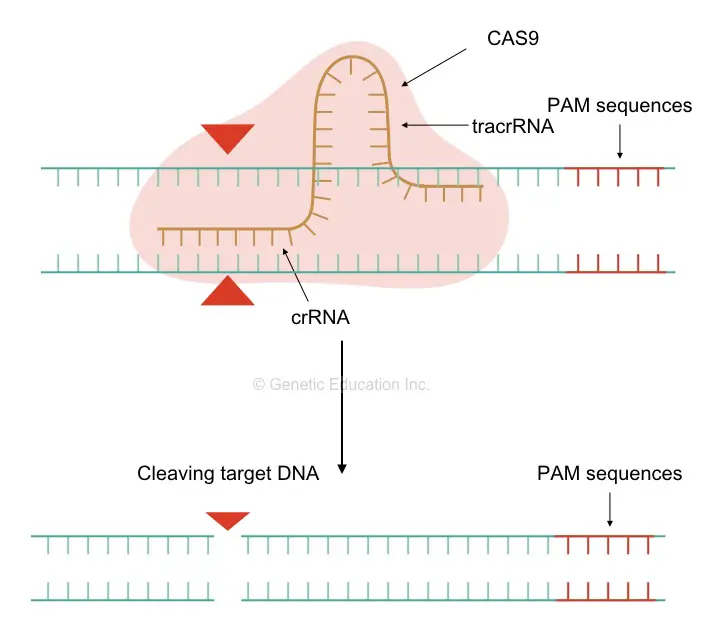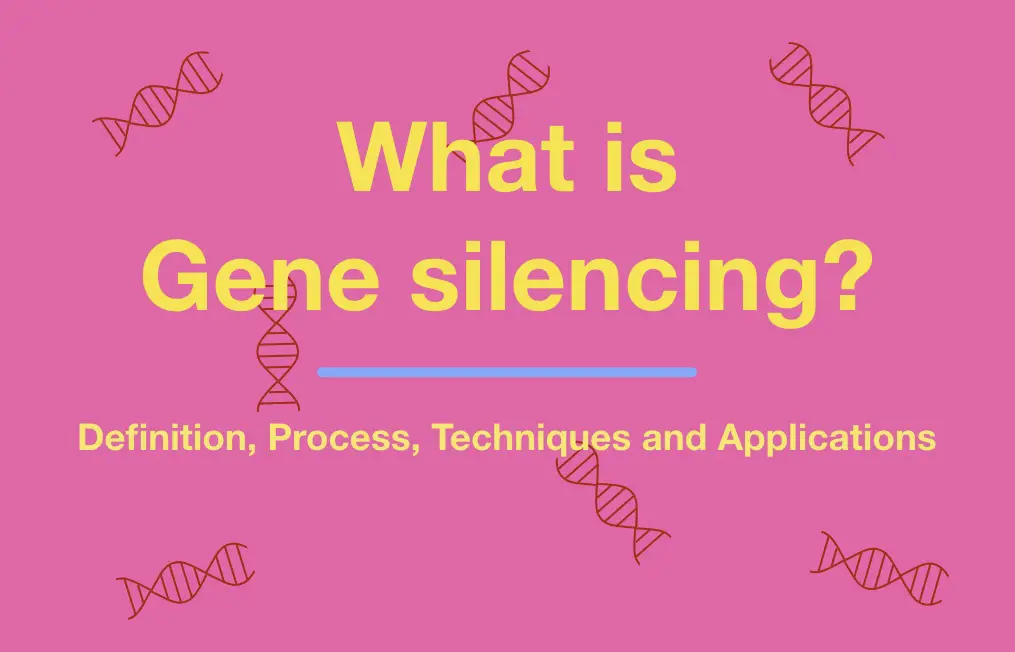“Gene silencing is a method to reduce or suppress the expression of a gene for various applications.”
Genes manufacture proteins and it’s a sequence of DNA. Every gene has a specific expression spectrum. Gene expression is defined as, ‘in how much amount a particular protein is formed from a gene in a particular cell type.’
Let me tell you first, that genes, mRNA and protein are formed from replication, transcription and translation, respectively.
The entire gene set of a cell expresses in a controlled manner. If the expression profile is altered (increases or decreases) it can cause disease possibly cancer.
For example, If the expression of tumor suppressor genes increases, it causes cancer.
So change in the expression of genes causes health issues, then why are we performing gene silencing? Are there any applications for it?
In the present article, we will explain to you the importance of gene silencing, some methods, and its applications.
Key Topics:
What is gene silencing?
Gene silencing is a modern gene-editing technique used for genetic engineering experiments. Using techniques like RNA interference, CRISPR-CAS9 and antisense RNA technique, a gene of our interest can be suppressed or its expression is controlled.
Let us take an example to understand the whole gene expression system. A gene known as CASCADE makes a protein that helps in the regulation of the cell cycle. Now, due to some unknown reason the CASCADE activity is imbalanced and produces more proteins than normal.
That overactivity of CASCADE disrupts the cell cycle and causes abnormal cell growth, what does it mean?
It’s cancer, governed by the overexpression of CASCADE protein. So in order to control its expression, we have to suppress or reduce its activity.
If you somehow manage to mutate the CASCADE gene or mRNA formed by it, we can control its expression. For instance, we are using a biomolecule that breaks the mRNA of the CASCADE gene, henceforth, a protein can’t form and we can control the overexpression of it.
Now you understand why we are performing the gene silencing, right! Besides, the gene silencing is also applicable in other fields as well that we will discuss in the upcoming section of this article.
Notably, the gene silencing mechanism is also present in a cell naturally that helps to control the gene activity.
Definition:
A method to silence, suppress or reduce the expression of certain genes or genes of our interest by genetic engineering techniques, is known as gene silencing.
Or
In a cell suppressing gene activity to regulate its expression through some natural mechanism is known as gene silencing.
Importance of gene silencing:
We are talking about artificial techniques of gene silencing but a natural mechanism is also present in organisms that help them to survive.
For instance, a CRISPR-CAS9 system of bacteria is used as a defense system by the prokaryotes. This system helps bacteria to invade phage or viruses.
Comprehensively the mechanism is as stated. A CAS9 nuclease binds to the target nucleic acid of phase and destroys it.
That is how it protects the bacteria from the attack of viral genes.
Yet in another mechanism (in eukaryotes especially), a special class of non-coding RNA recognizes the mRNA transcript and makes it inactive.
By artificial means, we can suppress some phenotypes by silencing related genotypes and can also produce new combinations of phenotypes using the gene silencing methods.
Related article: genotype vs phenotype.
Types of gene silencing:
RNA interference-mediated gene silencing:
In the RNAi mechanism, either siRNA or miRNA governs the process of gene silencing. Here the siRNA is the small interfering RNA while the miRNA is microRNA, both are non-coding RNAs that regulate gene expression through different mechanisms.
Both types of RNA are of 20 to 30 nucleotides in length and bind to the mRNA for performing a specific action.
The siRNA binds to the mRNA and cleaves it which makes it unavailable to form protein while the miRNA binds to the target mRNA transcript, and blocks binding of translational factors thereby blocks translation.
Both mechanisms are known as RNA interference for gene silencing using which a cell invades pathogenic attack. The biochemical pathway includes the RISC and DICER complex formation in the path of action.
We have covered separate articles on RNA interference, microRNA and small interfering RNA. You can read it here:
- RNA Interference (RNAi): A Process Of Gene silencing
- microRNA (miRNA) and Gene Regulation
- siRNA (Small Interfering RNA): Structure And Function
Transcriptional gene silencing
Yet another proven gene silencing pathway in gene silencing by epigenetic factors.
Epigenetic factors such as methylation, acetylation, histone modifications and chromatin remodeling also make genes inactive.
DNA methylation is the most popular mechanism and known to us for gene silencing, right! The enzyme SAM adds methyl groups on the CpG region of DNA and makes it inactive.
During histone modification, histones like H2A, H2B, H3 and H4 make a complex with DNA (known as nucleosome), converts it in the heterochromatin region and makes it transcriptionally inactive.
Chromatin remodeling is also one of them that does do the same. All these epigenetic factors help DNA or genes to pack so tightly thus enzymes and transcriptional factors can’t access it. They can’t form protein, resultantly.
Related article: Inside chromatin- definition, structure and function.
Transposons in gene silencing:
The transposons are the mobile genetic elements that can move from one place to another place in a genome.
DNA transposons and retrotransposons are two types of transposon systems present commonly in prokaryotes and eukaryotes, respectively.
Transposable elements are the natural genetic elements involved in gene silencing. The elements jump from one location to the active gene where it inserts in it. The active gene now has some extra gene sequence that is not a part of it actually, hence it can’t perform translation.
The sleeping beauty transposon system is now used in genetic engineering to manipulate gene expression.
Antisense oligonucleotides:
We can use a method in which by designing some short-nucleotide sequences specific to the mRNA we wish to silence, to make a gene inactive. This method is known as antisense oligonucleotides.
The present method was first reported by Paul Zamecnik and Mary Stephenson in 1978.
The complementary antisense nucleotides hybridize to its complementary region on mRNA and either cleave it using the RNase H or blocks the translation by some other means.
In both cases, mRNA can’t form a protein. The method is traditionally known as antisense RNA technology.
CRISPR-CAS9 gene silencing:
CRISPR-CAS9 is a great tool for gene editing, we know it! But do you know, we can use it for silencing genes?
In normal CAS9 activity, the single-stranded guided RNA recognizes the nuclease CAS9 and guides it to cleave the nucleic acid sequence. And hence the gene can’t form protein, but wait, how we can silence or reduce gene expression!
Scientists have developed a special type of CAS9 nuclease that can bind to the target nucleic acid or gene but can’t cut it, consequently, the polymerase and other transcriptional factors can’t identify the sequence. Protein can not form from it, resultantly.
Besides the antisense oligonucleotide techniques and altered CRISPR-CAS9, other gene silencing methods naturally occur in prokaryotes and eukaryotes as their defense system to protect a cell.
In addition to this, in mammals, the gene silencing regulates the cell cycles and cell division. The RNA silencing or suppressing has an important role in the metabolism of cells but why are we using it in in vitro studies and what are its applications? Let us check it out.

Applications of gene silencing:
Gene silencing has a tremendous role in genetic engineering and transgenic construction. In the plant genetics various economically important plants can be constructed using the present method.
In the medical field, the gene silencing technique is used to study genes associated with cancer, infectious disorders and other genetic disorders.
As we said, overexpression of some genes causes cancer, which is silenced by the shRNA and miRNA mediated technique.
The gene silencing is also used in plant genetics for creating genetically modified organisms or plants that are economically important.
The siRNA mediated gene silencing is used in treating infectious diseases like HIV. Here the viral RNA gene is targeted using the siRNA which binds to it and makes it inactive transcriptionally.
This technique is now under the trial phase for HIV and hepatitis infection, although results are unambiguous.
Scientists are now applying the gene silencing method to treat diseases like asthma, cystic fibrosis, chronic obstructive pulmonary disease, hepatitis B, hepatitis C, chronic myeloid leukemia and neurodegenerative disorders.
Genetically engineered plant species that produce less toxin are now constructed using the present RNA interference technique.
It is used in agribiotechnology, microbiology, food processing technology and in other science fields for various applications.
The process of artificial gene silencing:
Every genetic engineering technique is almost the same as having some common steps.
Let us understand the entire process of artificial gene silencing by taking an example, it’s fun!
The edible asparagus contains a toxin spirostanol saponins. If we disrupt the function of one of the genes involved in the metabolism of present toxins, our work is done.
Suppose we think that we are inactivating a gene known as ASP5.
We are using an RNA interference gene silencing using the shRNA. For that, the artificial double-stranded short 17 to 20 nucleotides long shRNA is constructed and inserted into the plant cell directly using the electroporation method.
Or we can insert a gene for the microRNA specific to the mRNA of the ASP5 gene into the plasmid.
The plasmid is transferred to the Agrobacterium to infect the target plant. The gene for microRNA inserts into the plant genome and makes a microRNA to cleave the mRNA of the ASP5 gene.
After the construction of microRNA, a cell produces less amount of toxins. Because every time the miRNA binds to the ASP5 gene and doesn’t allow it to transcribe.
In another method, the process remains the same but we can cleave the gene ASP5 and make it inactive.
But inactivating the entire gene might not be helpful to a plant, though it might help us in terms of reducing the toxin.
You know the poison secreted by a snake is harmful to us but it’s their digestive juices.
So the wise idea is to reduce the expression, not to make the whole gene inactive.
Using various approaches we can create various transgenic plant, animal and model organisms to silence various genes.
Gene knockdown vs gene silencing:
The gene knockdown and gene silencing are two different techniques, students mistaken to consider as similar.
In the gene knockdown we are stopping our genes from expressing, means, we are disrupting the genes normal function and protein can’t form.
This technique is used to stop the production of faulty protein but can’t minimize gene expression.
While in gene silencing technique, we are making a gene inactive to some extent, means, we are not inactivating it entirely. So overall the expression of a gene or amount of protein formation reduces but won’t stop!
Don’t be confused between both techniques.
Conclusion:
The mechanism of gene silencing makes genes inactive, now we know it. But it may sometimes cause adverse effects even in plants. That is why the gene manipulation, gene editing and gene silencing techniques must be used by prior permission.
Scientists are now almost ready with the novel gene silencing approach mediated by RNA interference for Huntington’s disease. Also, various approaches to different genetic diseases are now under the research phase.


